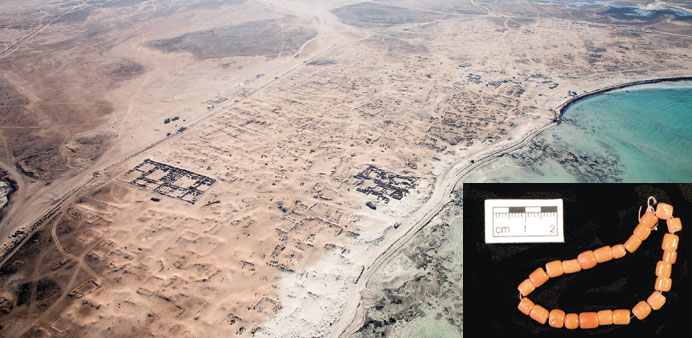An aerial view of Al Zubara showing areas under excavation. Inset: A string of coral beads found at Zubara. PICTURES: QMA
Qatar yesterday received its first World Heritage site inscription for Al Zubarah Archaeological Site.
Al Zubarah Archaeological Site, one of the largest and best-preserved examples of an 18th-19th century traditional pearl fishing and merchant town in the Gulf, was inscribed onto the Unesco World Heritage List at the 37th session of the World Heritage Committee conference in Cambodia.
It is the first entry for a Qatari site on the international register and one of 911 natural and cultural properties world-wide.
The inscription to the Unesco (United Nations Educational, Scientific and Cultural Organisation) World Heritage List is a unique opportunity for a country to build local and international awareness for the site and the values of the World Heritage Convention. Once a site has been put forward by the country, it goes through an evaluation process which often lasts several years. Other sites that hold this title include the Yellowstone Natural Park in the United States of America and the Pyramids of Giza in Egypt.
A historic coastal town that is now abandoned, Al Zubarah is situated about 100 km north-west of Doha. Founded in the mid-18th century, the town developed into a centre of the pearling and international trade and rose to become the country’s largest and most important settlement. it was abandoned by the mid-20th century.
Al Zubarah Archaeological Site covers an area of 60 hectares with remains of houses, mosques, large fortified buildings and a market.
Sheikh Hassan bin Mohamed bin Ali al- Thani, vice chairman of the Board of Trustees of Qatar Museums Authority (QMA), who was present at the Unesco event, commented: “It is very significant to include Al Zubarah in Qatar as part of the Unesco World Heritage list as a historical site that must be protected. This follows the enormous effort by Qatar in ensuring the preservation and conservation of this historical site, leading it to be internationally recognised for its human legacy”.
He called Al Zubarah “significant to many Gulf nationals”.
Al Zubarah was first reported as an archaeological site by a Danish-led team of archaeologists in the 1950s, and then excavated by Danish and Qatari teams. As a result of the studies conducted at the site, a large number of archaeological finds from the 18th-19th centuries are now part of the National Museum of Qatar’s (NMoQ’s) permanent collection, and will be featured in the museum galleries.
According to Unesco, Al Zubarah had trading links across the Indian Ocean, Arabia and Western Asia. A layer of sand blown from the desert has protected the remains of the site’s palaces, mosques, streets, courtyard houses, fishermen’s huts, harbour and double defensive walls, a canal, walls and cemeteries.
Excavation has only taken place over a small part of the site, offering an outstanding testimony to an urban trading and pearl-diving tradition which sustained the region’s major coastal towns and led to the development of small independent states that flourished outside the control of the Ottoman, European and Persian empires and eventually led to the emergence of modern-day Gulf states.
The Unesco designation as a World Heritage Site brings Zubarah more explicitly under the protection of the Law of War under the Geneva Convention.
During Unesco’s 37th session in Cambodia , India’s Hill Forts of Rajasthan, Canada’s Red Bay Basque Whaling Station and Namibia’s Namib Sand Sea, among others, were inscribed into the list.

